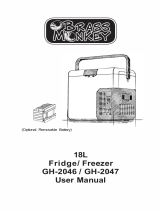
19
CONTACT US
290L SOLAR POWERED DC FRIDGE
1 YEAR LIMITED WARRANTY
Unique Gas Products Ltd. warrants that this UNIQUE fridge is free from defects in material and workmanship under
normal usage and service under the following terms:
Parts Warranty
This appliance has been designed for domestic household use. If properly installed, adjusted and operated under
normal conditions in accordance with printed instructions, it will satisfactorily perform the functions that are generally
expected of this type of appliance.
If the appliance fails to do so because of a defect in material or workmanship within one year from the original date
of purchase: Unique will at our option, repair, exchange, or correct by other means Unique consider appropriate, any
part(s) Unique finds to be defective except for the surface finish. *Due to remote locations, it is the customer’s respon-
sibility to bring items to the dealer for review. Any part(s) replaced or repaired will be warranted only for the balance
of the original year. Customer is responsible for labor.
Ownership
This Warranty is made only to the first purchaser (”original purchaser”) who acquires this fridge for his/her own use
and will be honored by Unique Gas Products Ltd. and by the Seller. Purchaser must retain their receipt as proof of
purchase date.
Warranty Conditions
This warranty does not apply to any appliance that has been subjected to alterations, misuse, abuse (including
damage by foreign agents or chemicals), accident, improper installation or service, delivery damage, or other than
normal household use and service. This UNIQUE appliance must be serviced regularly as outlined in the Owner’s
Manual. Neither Unique Gas Products Ltd. nor the selling dealer will be liable for direct or indirect loss of foods caused
by failure in operation. In case of damage, the owner must provide proof of purchase, Model, and Serial Number to the
selling dealer or Unique Gas Products Ltd. This warranty is LIMITED STRICTLY to the terms indicated herein, and no other
expressed warranties or remedies thereunder shall be binding on Unique.
Purchaser’s Responsibilities
The purchaser will be responsible for the costs of any service calls requested to demonstrate or confirm the proper
operation of the appliance, the installation, or to correct malfunctions in the appearance created by the operation of
the appliance in a manner not prescribed by or cautioned against in the use and care instructions.
Model and Serial Number
The appliance model number and serial number can be found on a rating plate attached at the back of the fridge. The
purchaser should always refer to the model and serial number when talking to or contacting the dealer from whom
the appliance was purchased.
Factory Assistance
If the purchaser is unable to locate an authorized dealer/service agent, or if the purchaser does not receive satisfaction
from the dealer, they may contact Unique Gas Products Customer Service directly at Toll Free 1-877-427-2266
or 905-827- 6154
For questions related to the operation, safety or the purchase of your fridge, please contact your dealer for more
information. For general information, contact our customer service department:
• Toll-free: 1-877-427-2266 or 1-905-827-6154 (available during regular business hours, 8:30 am to 4:30 pm, EST.
• Address: Unique Gas Products Ltd., 2245 Wyecroft Road, Oakville, Ontario, Canada, L6L 5L7























